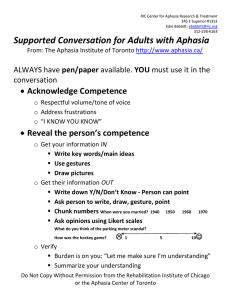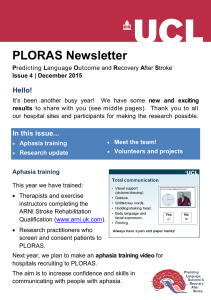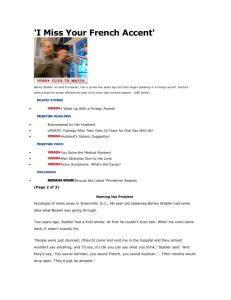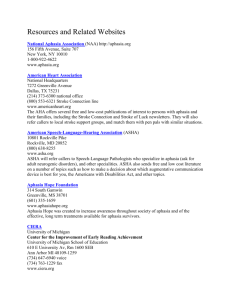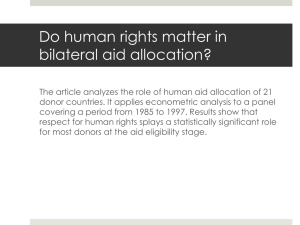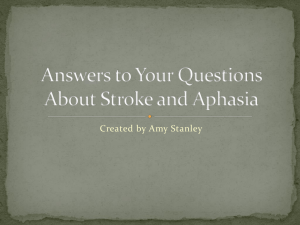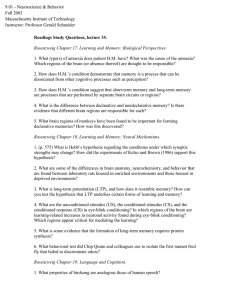Curriculum Vitae Julius Fridriksson, Ph.D., CCC-SLP USC Health Sciences Distinguished Professor
advertisement
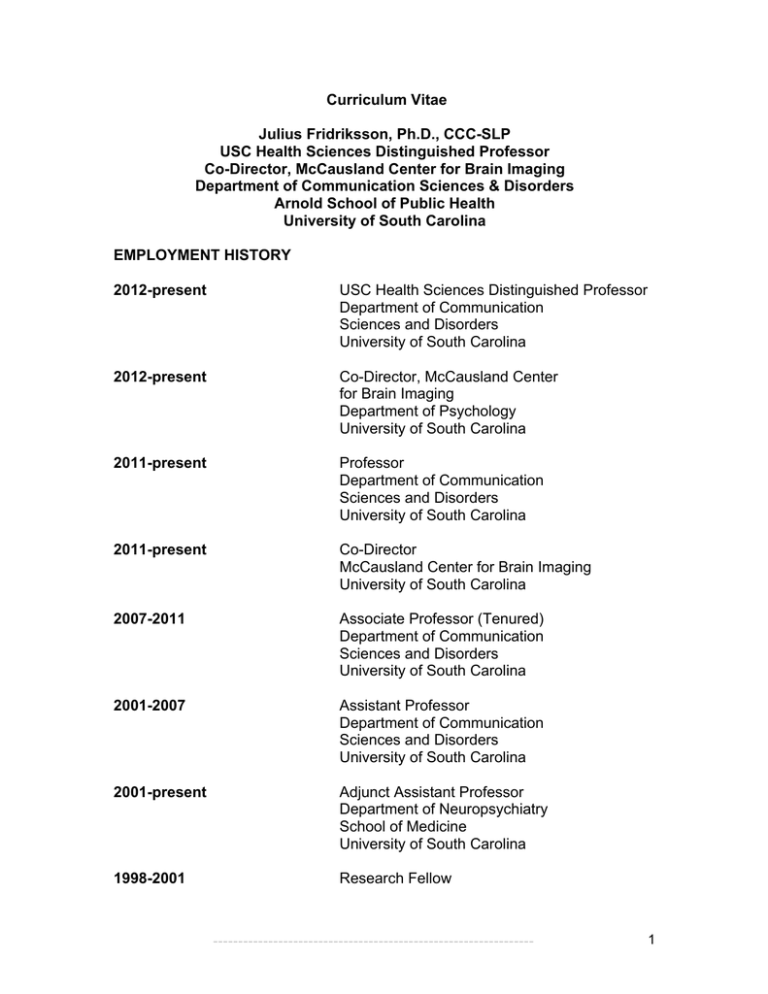
Curriculum Vitae Julius Fridriksson, Ph.D., CCC-SLP USC Health Sciences Distinguished Professor Co-Director, McCausland Center for Brain Imaging Department of Communication Sciences & Disorders Arnold School of Public Health University of South Carolina EMPLOYMENT HISTORY 2012-present USC Health Sciences Distinguished Professor Department of Communication Sciences and Disorders University of South Carolina 2012-present Co-Director, McCausland Center for Brain Imaging Department of Psychology University of South Carolina 2011-present Professor Department of Communication Sciences and Disorders University of South Carolina 2011-present Co-Director McCausland Center for Brain Imaging University of South Carolina 2007-2011 Associate Professor (Tenured) Department of Communication Sciences and Disorders University of South Carolina 2001-2007 Assistant Professor Department of Communication Sciences and Disorders University of South Carolina 2001-present Adjunct Assistant Professor Department of Neuropsychiatry School of Medicine University of South Carolina 1998-2001 Research Fellow ---------------------------------------------------------------- 1 Department of Speech and Hearing Sciences University of Arizona 1997-1998 Speech Pathologist Avante Rehabilitation Center Leesburg, Florida EMAIL WEB site jfridrik@sc.edu http://www.mccauslandcenter.sc.edu/aphasia/ HOME ADDRESS 305 Cartgate Circle Blythewood, SC 29016 CITIZENSHIP USA/Iceland EDUCATION 1991 Studentsprof, Economics, Sudurnes College, Iceland 1995 B.A., Communicative Disorders, University of Central Florida 1997 M.A., Speech-Language Pathology, University of Central Florida 2001 Ph.D., Speech-Language Pathology, University of Arizona HONORS 1993-1995 1995 1998-2001 2010 2011 2011 2011 2013 2013 Golden Key National Honors Society Graduated Cum Laude (B.A.) University of Central Florida Research Fellowship – National Center for Neurological Communication Disorders Researcher of the Year Award – Arnold School of Public Health, University of South Carolina Louis M. DiCarlo Award for Clinical Advancement, SCSHA Distinguished Alumnus Award, Dept. of Speech and Hearing Sciences, University of Arizona Louis M. DiCarlo Award for Clinical Advancement, American Speech and Hearing Foundation Outstanding Alumni Award for the Department of Communication Sciences and Disorders, University of Central Florida Professional Achievement Award for the College of Health and Public Affairs, University of Central Florida EXPERTISE Cognitive Neuroscience Stroke Recovery Stroke Rehabilitation Neuroimaging PROFESSIONAL ORGANIZATIONS American Speech and Hearing Association ---------------------------------------------------------------- 2 Organization for Human Brain Mapping Society for Neuroscience Society for the Neurobiology of Language South Carolina Speech and Hearing Association CURRENT FEDERAL FUNDING: Principal investigator, “National Institute on Deafness and other Communication Disorders.” Trans-cranial Direct Current Stimulation to Treat Aphasia: Phase II Trial (R01 DC011739. Funding period: 4/2012-3/2017; funding: $4,680,000). This is a phase II trial aimed at providing preliminary data to support and definitive phase III trial. The overall goal is to examine the effect of transcranial direct current stimulation on aphasia recovery in chronic stroke. Principal investigator, “National Institute on Deafness and other Communication Disorders.” Speech Entrainment Treatment for Broca's Aphasia (R21 DC014170. Funding period: 5/2015-4/2017, funding $275,000.00). The purpose of this pilot project is to estimate effect sizes associated with improvements in speech production as a result of speech entrainment treatment (SET) and to examine a new approach to treat Broca’s aphasia and explore patient characteristics associated with treatment response. Local PI, “National Institute on Deafness and other Communication Disorders.” Brain Connectivity Supporting Language Recovery in Aphasia. (R01 DC014021. Funding period: 6/2014-5/2019; funding: $1,703,101). The aim of this project is to investigate how residual structural brain connectivity enables recovery from aphasia in chronic stroke patients. All data collection for this project is accomplished in our NIDCD supported phase II trial (see above). PI: Bonilha COMPLETED FUNDING: Principal investigator, “National Institute on Deafness and other Communication Disorders.” A Unified Neuroanatomical Model of Speech Perception and Production: Implications (R01 DC009571. Funding period 4/1/2009-1/31/2015. Total budget: $1,633,947.00). This project examines the neural mechanism supporting speech perception and production. Special emphasis is placed on translating basic research findings into treatment of apraxia of speech and conduction aphasia. Renewal application received a ranking of 24th percentile. Resubmission planned in 2015. Principal investigator, “National Institute on Deafness and other Communication Disorders.” Neurological Predictors of Anomia Recovery in Aphasia (R01 DC008355. Funding period 4/1/2007-3/31/2013. Total budget: $1,598,940.00, no-cost extension has been approved for 2012-2013). This project investigates the relationship between cortical integrity and outcome of anomia treatment in stroke patients with aphasia. Renewal application has been submitted. ---------------------------------------------------------------- 3 Principal investigator, “National Institute on Deafness and other Communication Disorders.” Administrative supplement: Neurological Predictors of Anomia Recovery in Aphasia, (DC008355-03S1. Funding period 7/17/2009- 06/30/2011. Total budget: $152,200.00). The purpose of this project is to develop a novel method to carry out lesion-symptom mapping using tractography data in stroke patients. Currently in ‘no-cost extension.’ Principal investigator, “National Institute on Deafness and other Communication Disorders.” Administrative supplement: A Unified Neuroanatomical Model of Speech Perception and Production: Implications (DC009571-01A1S1. Funding period 7/17/2009- 06/30/2011. Total budget: $158,400.00). The purpose of this research is to develop a computerized treatment for speech production in aphasia. Currently in ‘no-cost extension.’ Principal investigator, “National Institute of Deafness and other Communication Disorders.” Neurological Predictors of Aphasia Recovery (R03 DC005915 funding period: 8/1/03-7/31/07; total funding: $225,000.00). The purpose of this study was to investigate the relationship among cerebral perfusion, lesion size, aphasia, and left hemi-spatial neglect in early stroke. Co-PI, “Anonymous donor.” Brain atrophy and normal aging. (Funding period: 2006-2009; total funding: $100,000.00). The purpose of this research was to examine the relationship between white and gray matter atrophy in the normally aging brain and cognition. Co-PI: Leonardo Bonilha Co-investigator, “National Institute on Neurological Disorders and Stroke.” Dissociating Components of the Attentional Network in Neglect (R01 NS054266 funding period: 8/1/2006-7/31/2011. Total budget: $1,467,000.00). The purpose of this grant is to investigate brain damage associated with neglect in stroke patients. PI: Rorden Co-investigator, “National Institute on Aging.” Processing Discourse Reference in Mind and Brain, (R21 AG030445. Funding period: 5/1/20084/30/2010. Total budget: $432,000.00). This research aims to uncover the functional and neural processes that underlie reference comprehension, especially with respect to the relation between reference form and referent salience. PI: Almor. Co-investigator, “National Institute on Neurological Disorders and Stroke.” Targeted Transcranial Electrotherapy System to Accelerate Stroke Recovery, (R41 NS076123-01. Funding period: 7/1/2011-6/30/2013. Total budget: $511,797). The purpose of this project is to develop a computerized guidance system to best determine electrode placement on the scalp (using highresolution MRI) for transcranial direct current stimulation treatment of stroke. PI: Parra. ---------------------------------------------------------------- 4 Co-investigator, “National Science Foundation.” The neural basis of processing discourse reference. (BCS0822617. Funding period: 2009-2013. Total funding: $431,000.00). This basic science project focuses on understanding the dynamics of brain activation during sentence processing and relies of fMRI and EEG. PI:Almor Consultant, “National Institute on Deafness and Other Communication Disorders.” Semantic Feature Processing in Individuals with Stroke Aphasia (R03 DC010262. Funding period: 4/2010-3/2013. Total funding: $450,000.00). The overall objective of this project is to determine the relationships among semantic feature knowledge, word retrieval deficits, and lesion location in individuals with aphasia. PI: Antonucci PENDING/OTHER FUNDING: Principal investigator, “National Institute on Deafness and other Communication Disorders.” Center for the Study of Aphasia Recovery (C-STAR) (P50 DC014664. Funding period: 3/2016-2/2021, requested funding $11,400,000.00). The purpose of C-STAR is to accomplish trans-disciplinary research to improve understanding brain plasticity that supports aphasia recovery. Participating institutions: University of South Carolina, Medical University of South Carolina, Johns Hopkins University, University of California, Irvine. PEER REVIEWED PAPERS (names of students supervised by JF are italicized) 1. Ryalls, J., Baldauff, P., Fridriksson, J., Thornburgh, D., & Zipprer, A. (1999). Different phonetics for different folks: studies of speaker differences at UCF. Florida Journal of Speech-Language Pathology, 2, 43-44. 2. Fridriksson, J. & Holland, A.L. (2001). Final thoughts on management of aphasia in the early phases of recovery following stroke. American Journal of Speech-Language Pathology, 10(1), 37-39. 3. Holland, A.L. & Fridriksson, J. (2001). Aphasia management during the early phases of recovery following stroke. American Journal of SpeechLanguage Pathology, 10(1), 19-28. 4. Fridriksson, J. & Ryalls, J. (2002). Formant frequency differences in vowels produced by African American and Caucasian Male speakers. Florida Journal of Speech-Language Pathology, 20, 19-22. 5. Fridriksson, J., Holland, A.L., Coull, B., Plante, E., Trouard, T., & Beeson, P. (2002a). Association between cerebral perfusion/diffusion and aphasia severity in stroke. Stroke 33(1), 366-367. ---------------------------------------------------------------- 5 6. Fridriksson, J., Holland, A.L., Coull, B., Plante, E., Trouard, T., & Beeson, P. (2002b). Aphasia severity: association with cerebral perfusion and diffusion. Aphasiology, 16(9), 859-871. 7. Fridriksson, J., Holland, A., & Beeson, P, & Morrow, K.L. (2005). Spaced retrieval treatment of anomia. Aphasiology, 19(2), 99-109. 8. Fridriksson, J. & Morrow, L. (2005). Cortical activation associated with language task difficulty in aphasia. Aphasiology, 19(3/4/5), 239-250. 9. Fridriksson, J., Ryalls, J., Rorden, C., Morgan, P.S., George, M., & Baylis, G.C. (2005). Brain damage and cortical compensation in foreign accent syndrome. Neurocase, 11, 1-6. 10. Fridriksson, J., Frank, E.M., & Vesselinov, R. (2005). Utilization of speech pathology and audiology services in stroke patients. Journal of Medical Speech Language Pathology, 13(4), 223-232. 11. Morrow, K.L. & Fridriksson, J. (2006). Comparing fixed-and randomized-interval spaced retrieval in anomia treatment. Journal of Communication Disorders, 39(1), 2-11. 12. Fridriksson, J., Rorden, C., Morgan, P.S., Morrow, L., & Baylis, G.C. (2006). Measuring the hemodynamic response in the case of delayed perfusion. Neurocase, 12(3), 146-50. 13. Bonilha, L., Moser, D., Rorden, C., Baylis, G., & Fridriksson, J., (2006). Speech apraxia without oral apraxia: can normal brain function explain the physiopathology? Neuroreport, 17(10), 1027-31. 14. Fridriksson, J., Nettles, C., Davis, M., Morrow, L., & Montgomery, A. (2006). Functional communication and executive function in aphasia: Preliminary data. Journal of Clinical Linguistics and Phonetics, 20(6), 401-410. 15. Fridriksson, J., Morrow, K.L., Moser, D., Fridriksson, A., & Baylis, G.C. (2006). Neural recruitment associated with anomia treatment in aphasia. NeuroImage, 32, 1403-1412. 16. Fridriksson, J., Morrow, K.L., Moser, D., & Baylis, G.C. (2006). Age related variability in cortical activity during language processing. Journal of Speech-Language-Hearing Research, 49(4), 690-697. 17. Hall, D., Holmes, R.M., & Fridriksson, J. (2006). Frequency and periodicity coding in human auditory cortex. European Journal of Neuroscience, 24, 3601-3610. ---------------------------------------------------------------- 6 18. Fridriksson, J., Moser, D., Bonilha, L., Morrow, K.L., Shaw, H., Fridriksson, A.M., Baylis, G.C., & Rorden, C. (2007). Neural Correlates of Phonological and Semantic Based Anomia Treatment in Aphasia. Neuropsychologia, 45, 1812-22. 19. Almor, A., Smith, D.V., Bonilha, L., Fridriksson, J., & Rorden, C. (2007). What’s in a name? The brain basis of using pronouns and repeated names. Neuroreport, 18, 1215-9. 20. Davis, M.S., Fridriksson, J., Healy, E.W., & Baylis, G.C. (2007). Effects of MRI scanner noise on language task performance in persons with aphasia. Journal of Medical Speech-Language Pathology, 15, 119-126. 21. Healy, E.W., Morrow, K.L., Moser, D., Hall, D., & Fridriksson, J. (2007). Speech perception in scanner noise by persons with aphasia. Journal of Speech-Language-Hearing Research, 50, 323-34. 22. Healy, E.W., Moser, D.C., Morrow, K.L., & Fridriksson, J. (2007). Within-session learning of novel auditory tasks by persons with aphasia. Journal of Medical Speech Language Pathology, 15, 327-335. 23. Hirth, V., Davis, J., Fridriksson, J., Rorden, C., & Bonilha, L. (2007). Cognitive performance and neural correlates of detecting driving hazards in healthy older adults. Dementia and Geriatric Cogn. Dis., 24(5), 335342. 24. Moser, D., Fridriksson, J., & Healy, E.W. (2007). Sentence comprehension and general working memory. Journal of Clinical Linguistics and Phonetics, 21(2), 147-156. 25. Fridriksson, J., Bonilha, L., & Rorden, C. (2007). Severe Broca’s aphasia without Broca’s area damage. Behavioural Neurology, 18(4), 237-238. 26. Fridriksson, J., Moss, J., Davis., B., Baylis, G.C., Bonilha, L., & Rorden, C. (2008). Motor speech perception modulates the cortical language areas. Neuroimage, 41, 605-613. 27. Rorden, C., Davis, B., George, M.S., Borckardt, J., & Fridriksson, J. (2008). Broca’s area is crucial for visual discrimination of speech but not non-speech oral movements. Brain Stimulation, 1(4), 383-385. 28. Bonilha, L.F., Eckert, M.A., Fridriksson, J., Hirth, V.A., Moser, M., Morgan, P.S., & Rorden, C. (2009). Age-related relative volume ---------------------------------------------------------------- 7 preservation of the dominant hand cortical region. Brain Research, 1305, 15-19. 29. Bonilha, L. & Fridriksson, J. (2009). Subcortical damage and white matter disconnection associated with non-fluent speech. Brain, 132, e108. 30. Fridriksson, J., Baker, M.J., Whiteside, J., Eoute, D., Moser, D., Vesselinov, R., & Rorden, C. (2009). Treating visual speech perception to improve speech production in non-fluent aphasia. Stroke. 40(3), 8538. 31. Fridriksson, J., Baker, J., & Moser, D. (2009). Cortical mapping of naming errors in aphasia. Human Brain Mapping, 30(8), 2487-2498. 32. Fridriksson, J., Moser, D., Ryalls, J., Bonilha, L., Rorden, C., & Baylis, G.C. (2009). Modulation of frontal lobe speech areas associated with the production and perception of speech movements. Journal of SpeechLanguage-Hearing Research, 52(3), 812-9. 33. Moser, D., Fridriksson, J., Rorden, C., Bonilha, L., Healy, E.W., Baker, J., & Baylis, G.C. (2009). Neural recruitment for the production of native and novel speech sounds. NeuroImage, 46(2), 549-57. 34. Moser, D., Baker, J.M., Sanchez, C.E., Rorden, C., & Fridriksson, J. (2009). Temporal order processing of syllables in the left parietal lobe. Journal of Neuroscience, 9(40), 12568-73. 35. Rorden, C., Fridriksson, J., & Karnath, H.O. (2009). An evaluation of traditional and novel tools for lesion behavior mapping. Neuroimage, 44(4), 1355-62. 36. Turner, T.H., Fridriksson, J., Baker, J., Eoute, D., Bonilha, L., & Rorden, C. (2009). Obligatory Broca’s area modulation associated with passive speech perception. NeuroReport, 20(5), 492-6. 37. Fridriksson, J., Bonilha, L., Baker, J.M., Moser, D., & Rorden, C. (2010). Activity in preserved left hemisphere regions predicts anomia severity in aphasia. Cerebral Cortex, 20(5), 1013-9. 38. Baker, J., Rorden, C., & Fridriksson, J. (2010). Using transcranial direct current stimulation (tDCS) to treat stroke patients with aphasia. Stroke, 1229-36. 39. Bonilha, L. Edwards, J.C., Kinsman, S.L., Morgan, P.S., Fridriksson, J., Rorden, C., Rumboldt, Z., Roberts, D.R., Eckert, M.E., & Halford, J.J. ---------------------------------------------------------------- 8 (2010). Extra-hippocampal gray matter loss and hippocampal deafferentation in patients with temporal lobe epilepsy. Epilepsia, 51, 519-28. 40. Smith, D.V., Davis, B., Niu, K., Healy, E.W., Bonilha, L., Fridriksson, J., Morgan, P.S. & Rorden, C. (2010). Spatial attention evokes similar activation patterns for visual and auditory stimuli. Journal of Cognitive Neuroscience, 22(2), 347-61. 41. Fridriksson, J., Kjartansson, O., Morgan, P.S., Hjaltason, H., Magnusdottir, S., Bonilha, L.F., & Rorden, C. (2010). Impaired speech repetition and left parietal lobe damage. Journal of Neuroscience, 30, 11057-61. 42. Fridriksson, J. (2010). Preservation and modulation of specific left hemisphere regions is vital for treated recovery from anomia in stroke. The Journal of Neuroscience, 30(35), 11558-11564. 43. Richardson, J.D., Baker, J.M., Morgan, P.S., Rorden, C., Bonilha, L., & Fridriksson, J. (2011). Cerebral perfusion in chronic stroke: Implications for lesion-symptom mapping and functional MRI. Behavioural Neurology, 24(2), 117-22. 44. Fridriksson, J., Richardson, J.D., Baker, J.M., & Rorden, C. (2011). Transcranial direct current stimulation improves naming reaction time in fluent aphasia: A double-blind, sham-controlled study. Stroke, 42(3), 819-21. 45. Datta, A., Baker, J.M., Bikson, M., & Fridriksson, J. (2011). Individualized model predicts brain current flow during transcranial direct-current stimulation treatment in responsive stroke patient. Brain Stimulation, 4(3), 169-74. 46. Fridriksson, J. (2011). Measuring and inducing brain plasticity in chronic aphasia. J Comm Dis., 44(5), 557-63. 47. Fridriksson, J., Hubbard, H.I., & Hudspeth, S.G. (2012). Transcranial brain stimulation to treat aphasia: a clinical perspective. Semin Speech Lang, 3(3), 188-202. 48. Fridriksson, J. Richardson, J., Fillmore, P., & Cai, B. (2012). Left hemisphere plasticity and aphasia recovery. Neuroimage, 60, 854-863. 49. Christie, J., Ginsberg, J.P., Steedman, J., Fridriksson, J., Bonilha, L. & Rorden, C. (2012). Global versus local processing: seeing the left side of ---------------------------------------------------------------- 9 the forest and the right side of the trees. Frontiers in Human Neuroscience, 6, 28. 50. Rorden, C., Bonilha, L., Fridriksson, J., Bender, B. & Karnath, H-O. (2012). Age-specific CT and MRI templates for spatial normalization. NeuroImage, 16;61(4), 957-65. 51. Rorden, C., Hjaltason, H., Fillmore, P., Fridriksson, J., Kjartansson, O., Magnusdottir, S., & Karnath, H,O. (2012). Allocentric neglect is strongly associated with egocentric neglect. Neuropsychologia. 50(6), 1151-7. 52. Magnusdottir, S. Fillmore, P., Den Ouden, D-B, Hjaltason, H., Rorden, C., Kjartansson, O., Bonilha, L., & Fridriksson, J. (2013). Damage to left anterior temporal cortex predicts impairment of complex syntactic processing: A lesion symptom mapping study. Human Brain Mapping. 34(10), 2715-23 53. Richardson, J., Fillmore, P., Rorden, C., LaPointe, L., & Fridriksson, J. (2012). Re-establishing Broca’s Initial Findings. Brain & Language, 123(2), 125-30. 54. Fridriksson, J., Hubbard, H.I., Hudspeth, S.G., Holland, A.L., Bonilha, L., Fromm, D., & Rorden, C. (2012) Speech entrainment enables patients with Broca’s aphasia to produce fluent speech. Brain. 135, 3815-29. 55. Dmochowski, J., Bikson, M., Datta, A., Richardson, J., Fridrikson, J., Parra, L. (2013). On the Role of Electric Field Orientation in Optimal Design of Transcranial Current Stimulation. Conf Proc IEEE Eng Med Biol Soc. 6426-9. 56. Dmochowski, J., Datta, A., Huang, Y., Richardson, J., Bikson, M., Fridrikson, J., Parra, L. (2013). Targeted Transcranial Direct Current Stimulation for Rehabilitation after Stroke. Neuroimage. 12-9. 57. Fridriksson, J., Guo, D., Fillmore, P., Holland, A., & Rorden, C. (2013) Damage to the anterior arcuate fasciculus predicts non-fluent speech production in aphasia. Brain. 136, 3451-60. 58. Bonilha, L., Nesland, T., Rorden, C., & Fridriksson, J. (2014). Asymmetry of the structural brain connectome in healthy older adults. Frontiers in Psychiatry. 4, 186. 59. Bonilha L., Rorden, C., & Fridriksson, J. (2014). Assessing the clinical impact of residual cortical disconnection after ischemic strokes. Stroke, 45(4), 988-93 ---------------------------------------------------------------- 10 60. Bonilha, L., Nesland, T., Rorden, C., Fillmore. P., Ratnayake, R., & Fridriksson, J. (2014). Mapping remote subcortical ramifications of injury after ischemic strokes. Behavioral Neurology. 45(4), 988-93. 61. Plante, E., Patterson, D., Dailey, N., Almryde, K., Fridriksson, J. (2014). Dynamic changes in network activations characterize early learning of a natural language. Neuropsychologia, 62, 77-86. 62. Basilakos, A., Fillmore, P.T., Rorden, C., Guo, D., Bonilha, L., & Fridriksson, J. (2014). Regional white matter damage predicts speech fluency in chronic post-stroke aphasia. Front Hum Neurosci, 17 (8). 63. Richardson, J.D., Fillmore, P., Datta, A., Bikson, M., & Fridriksson, J. (2014). Toward development of sham protocols for transcranial direct current stimulation using high definition electrodes. NeuroRegulation, 1(1). 64. Fridriksson, J., Fillmore, P., Guo, D., Rorden, C. (in press). Chronic Broca’s aphasia is caused by damage to Broca’s and Wernicke’s areas. Cerebral Cortex. 65. Richardson, J.D., Fridriksson, J., Datta, A., Dmochowski, J., & Parra, L.C. (2015). High-definition transcranial direct current stimulation (HDtDCS) to enhance computerized treatment outcomes in persons with aphasia: A feasibility study. NeuroRehabilitation, 36(1), 115-26. 66. Fedorenko. E., Fillmore, P., Smith, K., Bonilha, L., Fridriksson, J. (2015). The Superior Precentral Gyrus of the Insula does not appear to be functionally specialized for articulation. J Neurophysiol, 113(7), 237682. 67. Moser, M.D., Basilakos, A., Fillmore, P., & Fridriksson, J. (in press). Localization of Apraxia of Speech: Further Evidence from Case Studies. Neurocase. 68. Bonilha, L., Gleichgerrcht, E., Nesland, T., Rorden, C., & Fridriksson, J. (in press). Gray matter axonal connectivity maps. Front Psychiatry. 69. Gleichgerrcht, E., Fridriksson, J, & Bonilha, L. (2015). Neuroanatomical foundations of naming impairments across different neurological conditions. Neurology, 85(3), 284-92. 70. Desai, R.H., Herter, T., Riccardi, N., Rorden, C., & Fridriksson, J. (2015). Concepts within reach: Action performance predicts action language processing in stroke. Neuropsychologia, 71, 217-24. ---------------------------------------------------------------- 11 71. Kocher, M., Gleichgerrcht, E., Nesland, T., Rorden, C., Fridriksson, J., Spampinato, M., & Bonilha, L. (in press). Individual variability in the anatomical distribution of nodes participating in rich club structural networks. Frontiers in Neural Circuits. 72. Basilakos, A., Rorden, C., Bonilha, L., Moser, D., & Fridriksson, J. (in press). Patterns of Brain Damage that Predict Speech Production Errors in Apraxia of Speech and Aphasia Dissociate. Stroke. 73. Fridriksson, J., Basilakos, B., Hickok, G., Bonilha, L., & Rorden, C. (2015). Speech Entrainment Compensates for Broca’s Area Damage. Cortex, 69, 68-75. 74. Herath, P., Hanayik, T., Krebs, K., Dennis, L., Rorden, C., Fridriksson. J., & Sen, S. (in press). Resting state functional connectivity and thrombolysis mediated reperfusion in acute ischemic stroke: A pilot study. Journal of Neurological Science. 75. Kocher, M., Gleichgerrcht, E., Nesland, T., Rorden, C., Fridriksson, J., Spampinato, M.V., & Bonilha, L. (2015). Individual variability in the anatomical distribution of nodes participating in rich club structural networks. Front Neural Circuits, 9-16. 76. Bonilha, L., Gleichgerrcht, E., Nesland, T., Rorden, C., & Fridriksson, J. (2015). Success of anomia treatment in aphasia is associated with preserved architecture of global and left temporal lobe structural networks. Neurorehabil Neural Repair. 77. Bonilha, L., Gleichgerrcht, E., Fridriksson, J., Rorden, C., Breedlove, J.L., Nesland, T., Paulus, W., Helms, G., & Focke, N.K. (in press). Reproducibility of the structural brain connectome derived from 1 diffusion tensor imaging. PLOS I. NON-REFEREED ARTICLES 1. Fridriksson, J., Richardson, J. & Baker, J. (2010, July 06). What Can Neuroimaging Tell Us About Aphasia? The ASHA Leader. PUBLISHED ABSTRACTS OF PAPERS PRESENTED AT MEETINGS (PEER REVIEWED) 1. Fridriksson, J. & Ryalls, J. (1997, November). Effect of ethnic background on formant frequencies. Paper presented at the annual ASHA conference, Boston, MA. ---------------------------------------------------------------- 12 2. Fridriksson, J., Beeson, P., Plante, E., Ramage., A., & Trouard, T. (2000, May). Temporal aspects of the hemodynamic response in an aphasic individual. Poster presentation at the Clinical Aphasia Conference, Kauna, HI. 3. Fridriksson, J., Holland, A.L., & Beeson, P. (2001, June). Spaced retrieval treatment of anomia. Poster presentation at the Clinical Aphasia Conference, Santa Fe, NM. 4. Fridriksson, J., Holland, A.L., Coull, B., Plante, E., Trouard, T., & Beeson, P. (2002, February). Cerebral perfusion and diffusion in stroke: association with aphasia severity in the early phases of stroke. Poster presentation at the International Stroke Conference, San Antonio. 5. Fridriksson, J. (2002, February). Aphasia recovery: Neurological correlates. Paper presented at the annual South Carolina Speech and Hearing Association Conference, Hilton Head Island, SC. 6. Fridriksson, J., Healy, E.W., Spell, L.A., Sandifer, H., & Warren-Couch, K. (2003, February). Research methods for speech language pathologists. Platform presentation at the annual South Carolina Speech and Hearing Association Conference, Myrtle Beach. 7. Fridriksson, J. & Morrow, L. (2004, May). Cortical Activation and Language Task Difficulty in Aphasia. Poster presentation at the Clinical Aphasia Conference, Park City, UT. 8. Fridriksson, J. (2005, April). Brain plasticity associated with massed practice and errorless learning in aphasia. Platform presentation at the BICOEE Symposium, Medical University of South Carolina, Charleston, SC. 9. Morrow, L., Davis, M., & Fridriksson, J. (2004, February). Neuroimaging in aphasia: It’s not just black-and-white. Platform presentation at the annual South Carolina Speech and Hearing Association Conference, Hilton Head, SC. 10. Hall, D., Holmes, R.M., Fridriksson, J. (September, 2004). Is there a pitch map in the low-frequency region of the human auditory cortex? British Society of Audiology: Short papers meeting, London, UK. 11. Morgan, P.S., George, M.S., Kozel, A.F., Fridriksson, J., Baylis, G.C., Martel, A.L., & Moody, A.R. (May, 2004). Dynamic Contrast Enhanced Whole Brain Perfusion using a Rapid 3D T1-weighted Sequence at 1.5T and 3T. Platform presentation at the 12th Annual Meeting of the International Society for Magnetic Resonance in Medicine. Kyoto, Japan. ---------------------------------------------------------------- 13 12. Fridriksson, J. (June, 2006). Perception mirrors speech: See what I am saying? Poster presentation at the Human Brain Mapping Conference, Florence, Italy. 13. Fridriksson, J. & Bonilha, L. (2006, November). Neural correlates of anomia treatment in aphasia. The American Speech and Hearing Association Annual Conference, Boston, MA. 14. Moser, D., Bonilha, L., & Fridriksson, J. (2006, November). Neural activation associated with speech and non-speech motor movements. The American Speech and Hearing Association Annual Conference, Boston, MA. 15. Fridriksson, J., Moser, D.M., Baker, J. (2008, May). Cortical mapping of naming errors in aphasia. Platform presentation at the Clinical Aphasia Conference, Jackson Hole, WY. 16. Moser, D.M., Fridriksson, A.M., & Fridriksson, J. (2008, November). Comparing phonological and semantic based naming treatment in aphasia. The American Speech and Hearing Association Annual Conference, Chicago, IL. 17. Fridriksson, J. & Fridriksson, A.M. (2010, June). Predicting aphasia treatment success with structural and functional MRI. Poster presentation at the Human Brain Mapping Conference, Barcelona, Spain. 18. Fridriksson, J. (2014, June). Using neuroimaging to classify aphasia at the Clinical Aphasiology Conference, St. Simons, GA. 19. Fridriksson, J. (2014, Aug). Speech entrainment reveals a crucial role for efference copy for fluency speech production at the Society for the Neurobiology Language Conference, Amsterdam, Netherlands. INVITED LECTURES 1. Fridriksson, J. (2007, March). Reykjavik, Iceland.Cortical bases of speech production and perception. Icelandic Speech and Hearing Association. 2. Fridriksson, J. (2007, April). Neuroimaging: “Seeing” speech and hearing in the brain. Annual conference of the South Carolina Audiology Association. Columbia, SC. 3. Fridriksson, J., Rorden, C., Karnath, O.M., & Morgan, P.S. (2007, June). Neuroimaging. University of Iceland Medical Center. Reykjavik, Iceland. ---------------------------------------------------------------- 14 4. Fridriksson, J. & Byrd, C. (2008, February). Life in the fast lane: My experiences on the road to tenure. Lessons for Success conference by the American Speech and Hearing Association. Rockville, MD. 5. Fridriksson, J. (2008, October). Studying normal speech perception to improve treatment of aphasia. NIH-NIDCD lecture series. Bethesda, MD. 6. Fridriksson, J. (2009, January). Neurophysiology of aphasia recovery. NIH-NIDCD Council meeting. Selected as “outstanding new researcher.” Bethesda, MD. 7. Fridriksson, J. & Rorden, C. (2009, November). Neuroimaging and aphasia treatment research. Annual conference of the American Speech and Hearing Association, New Orleans, LA. 8. Fridriksson, J. (2010, February). Using tDCS to treat aphasia in stroke. 6th Annual Aging Research Day “Stroke: Unbuckling the Stroke Belt.” Folly Beach, SC. 9. Fridriksson, J. (2010). Measuring and inducing brain changes that promote aphasia recovery. The 20th Annual NIH/NIDCD-Sponsored Research Symposium, American Speech-Language-Hearing Association Convention, Philadelphia, Pennsylvania. 10. Fridriksson, J. (2011, June). Using tDCS to improve aphasia treatment outcome. Moss Rehabilitation Research Institute in Elkins Park, PA. 11. Fridriksson, J. (2012, May). Relying on old “tricks” to treat apahsia. The Herbert J. and E. Jane Oyer Endowed Lecture in human communication sciences and disorders. Michigan State University, MI. 12. Fridriksson, J., Dronkers, N. (2012, October). What is the role of the insula in speech and language? The fourth annual meeting of the Society for the Neurobiology of Language. San Sebastian, Spain. 13. Fridriksson, J., Blumstein, S., Thompson, C. (2013, February). Teaching the brain to speak again: New frontiers in trauma and stroke recovery. Real-time audiovisual feedback enables stroke patients to require speech. Linguistics Symposia at the AAAS Boston 2013. 14. Fridriksson, J. (2013, February). Speech entrainment to treat aphasia. South Carolina Speech-Language-Hearing Association. Columbia, SC. ---------------------------------------------------------------- 15 15. Fridriksson, J. (2013, March). Patient studies of language in the modern era. The 26th Annual 2013 CUNY Conference. Columbia, SC. 16. Fridriksson, J. (2013, November). Neural Correlates of Aphasic Speech. The 2013 American Speech-Language-Hearing Association. Atlanta, GA. 17. Fridriksson, J. (2014, June). Using electrical brain stimulation to treat aphasia. International Aphasia Rehabilitation Conference. Den Haag, Holland. 18. Fridriksson, J. (2014, November). Electrical brain stimulation and aphasia treatment. Academy of Neurological Communication Disorders and Sciences conference. Atlanta, GA. 19. Fridriksson, J. (2015, January). Lessons learned from running a clinical trial: tDCS to treat stroke. NYC Neuromodulation Conference. New York, NY. 20. Fridriksson, J. (2015, January). How are the long term effects of brain stimulation enhanced treatment of individuals with aphasia measured? NYC Neuromodulation Conference. New York, NY. 21. Fridriksson, J. (2015, February). Transcranial Direct Current Stimulation as Treatment for Post-stroke Aphasia. International Stroke Conference. Nashville, TN. BOOK CHAPTERS 1. Fridriksson, J. (2010). Neuroimaging and Brain Based Communication Disorders, Chapter 5. In Aphasia and Related Neurogenic Language Disorders. Ed. L. LaPointe. 2. Fridriksson, J. & Smith, K. (2015). Neuroplasticity Associated with Treated Aphasia Recovery. Chapter 80. In Neurobiology of Language, Eds. G. Hickok & S. Small. 3. Richardson, J.D. & Fridriksson, J. (2015). The Insular Cortex. Chapter 10. In Neurobiology of Language, Eds. G. Hickok & S. Small. COMMUNITY SERVICE Aphasia Groups, University of South Carolina Speech and Hearing Center, Founder and Consultant, 2001-present South Carolina Speech and Hearing Association, Research Committee Chairman, 2002-2003 ---------------------------------------------------------------- 16 South Carolina Educational Radio Network; Therapy Crucial for Recovery from Stroke. Featured on National Public Radio. 9/2003. ABC Primetime. Segment of foreign accent syndrome, 4/6/06. Featured as an expert discussant. UNIVERSITY SERVICE Faculty Senate, University of South Carolina, 2001-2002. Committee member: Research and Productive Scholarship grant committee, USC, 2003-2006. Several department and university wide search committees for new faculty. Advisory committee to the VP for Research, USC, on Center for Neuroscience Advisory committee – McCausland Center for Brain Imaging Chairman, Tenure and Promotion Committee Arnold School of Public Health, USC, 2013-2015. NATIONAL SERVICE Action Editor: Brain and Language Member: Working group (six members) tasked with constructing a five-year strategic plan (2012-2016) for the National Institute on Deafness and Other Communication Disorders. Member: Language and Communication Disorders Study Section (LCOM), NIH. Dates 10/2011-10/2015. Grant review service: NIH Review panels/study sections Study section 2011- LCOM 2010/10 LCOM 2010/10 ZDC1 SRB-Q 2010/05 ZDC1 2010/10 ZDC1 2010/05 CDRC 2009/10 LCOM Dates 2011-2015 10/4-5/2010 07/05/2010 01/14/2010 05/26/2010 02/04/2010 06/01-02/2009 SRA Weijia Ni Weijia Ni Susan Sullivan Shiguang Yang Shiguang Yang Christopher Moore Weijia Ni Agency CSR CSR NIDCD NIDCD NIDCD NIDCD CSR Other grant review panels Grant reviewer for the Medical Research Council (MRC), United Kingdom. Ad hoc reviewer for: ---------------------------------------------------------------- 17 American Journal of Speech Language Pathology Aphasiology Brain Brain Imaging of Behavior Brain and Language Current Biology International Journal of Communication Disorders Journal of Neurology, Neurosurgery, and Psychiatry Journal of Cognitive Neuroscience Journal of Speech-Language-Hearing Research Nature Reviews Neurology Neurocase Neuroimage Seminars in Speech and Language Stroke COURSES COORDINATED AND TAUGHT Graduate COMD 502 Neurocognitive Bases of Language (2002) COMD J502 Neurocognitive Bases of Language (2003-2012) COMD 705 Language Disorders in Adults (2002-present) COMD j705 Language Disorders in Adults (2012-present) COMD 800 Basics in Neuroimaging (2002-2003) COMD 800 Neurobiology of Lang. Disorders in Adults (2013) GRADUATE RESEARCH SUPERVISION Committee Chair (Major Advisor) Caroline Nettles (completed 2003) M.S.P. Mary Davis (completed 2005) Ph.D. Sarah Davis (completed 2004) M.S.P. Leigh Morrow (completed 2006) Ph.D. Dana Moser (completed 2004) M.S.P. Dana Moser (completed 2007) Ph.D. Julie Baker (completed 2009) Ph.D. Margaret Moore (completed 2007) M.S.P. David Eoute (completed 2010) Ph.D. Rebecca Degarmo (completed 2010) M.S.P Isabel Hubbard (completed 2014) Ph.D. Kimberly Smith (est. completion, 2015) Ph.D. Helga Thors (est. completion, 2016) Ph.D. Alexandra Basilakos (est. completion, 2016) Ph.D. POST-DOCTORAL FELLOWS - SUPERVISION Dana Moser, Ph.D. (2007-2009) Julie Baker, Ph.D. (2009-2011) Frank Hu, Ph.D. (2009-2010) ---------------------------------------------------------------- 18 Jessica Richardson, Ph.D. (2009-2012) Paul Fillmore, Ph.D. (2010-2014) ---------------------------------------------------------------- 19
